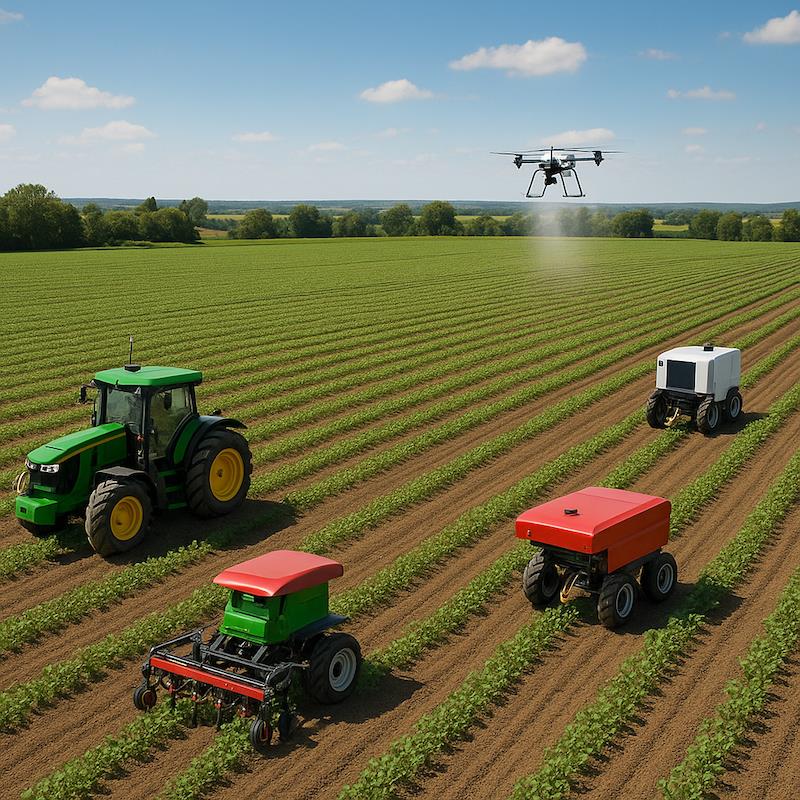
Agricultural Robots Drive Precision Farming And Autonomous Harvesting
| Laser weeding | Up to 80 percent reduction in herbicide use | 1–2 seasons |
| Robotic harvesting | Up to 50 percent cut in seasonal labor costs, operates 24/7 | Immediate to seasonal |
| Drone scouting | Saves $10-$15/acre in scouting costs; enables targeted inputs | Same season |
| Smart irrigation | 20-30 percent water savings, less manual labor | Same season |
These innovations address labor shortages, reduce chemical and water use, and lower operating costs – with ROI often realized within a single growing season.
Robotic harvesting: Challenges and progressHarvesting remains one of robotics' toughest nuts to crack: crops are delicate, ripeness varies, and fields lack uniformity. Yet progress is tangible:
A strawberry‐picking robot can harvest a 25‐acre field in just three days, replacing a crew of around 30 workers.
For apples, current robots pick at a pace of one fruit every 5-10 seconds, compared to humans who usually manage one per second.
In greenhouse and high-value specialty settings, deep‐learning‐enabled bots like AHPPEBot for tomatoes achieved an 86.7 percent success rate with an average pick time of 32.5 seconds.
Pruning robots are under development to address costs, given that pruning can account for up to 25 percent of labor in fruit/vine operations.
These figures underline both the engineering hurdles and the potential for automation to transform labor‐intensive stages of crop production.
Autonomous tractors and mobility platformsJohn Deere is advancing rapidly in autonomy:
-
At CES 2025, they revealed second-generation fully autonomous tractors, orchard sprayers, and even the remote dump truck“Dusty”, all designed to run without drivers using advanced camera, LiDAR, and AI systems.
Farmers have already deployed first-gen autonomous tractors since 2022 for planting prep, and Deere aims for fully autonomous corn and soybean systems by 2030.
Strategic acquisitions like Blue River Technology (for precision spraying) and Bear Flag Robotics (for autonomous vehicle tech) underscore Deere's push into robotics (acquisitions of about $305 million in 2017 and $250 million in 2021, respectively).
These investments point to confidence in autonomous platforms that reduce dependency on skilled drivers, increase uptime, and streamline farm logistics.
Broader efficiency gains via digital agricultureRobotics are part of a broader precision-agriculture ecosystem:
-
Tools like variable‐rate application, guidance systems, and soil and crop mapping can boost yields by 9-13 percent, while variable-rate irrigation can save ~25 percent water without hurting output.
Automated livestock systems – like milking robots – and greenhouse automation reduce labor and improve consistency.
For engineers, this means robotics are not standalone, but critical, nodes within smart farm networks. For investors, the aggregated ROI of these systems makes a compelling case.
Investment observations: Engineering value meets financial returnMarket size and growth: Billions in revenue now, with projections pointing toward $20-50 billion+ within the next decade. North America leads adoption.
-
Quantifiable ROI : Herbicide savings of nearly 60 percent, yield boosts, labor reductions – many systems break even within 1-2 seasons.
Strong corporate momentum : John Deere's strategic acquisitions, new autonomous tractors, and expansion of pilot programs validate long-term vision.
Engineering complexity and opportunity : Harvesting remains challenging; success in greenhouse and specialty contexts provides a clear R&D roadmap. Integrating robotics with drones, IoT, and AI platforms offers fertile ground for systems-level innovation.
For engineers, agricultural robotics is a high-stakes arena: it demands resilient mobility, robust perception, and soft-touch manipulation.
The work is hard, but the breakthroughs are tangible. For investors, the numbers are compelling: faster ROI, rising market demand, and enduring relevance in the face of demographic and sustainability pressures.
Legal Disclaimer:
MENAFN provides the
information “as is” without warranty of any kind. We do not accept
any responsibility or liability for the accuracy, content, images,
videos, licenses, completeness, legality, or reliability of the information
contained in this article. If you have any complaints or copyright
issues related to this article, kindly contact the provider above.


















Comments
No comment